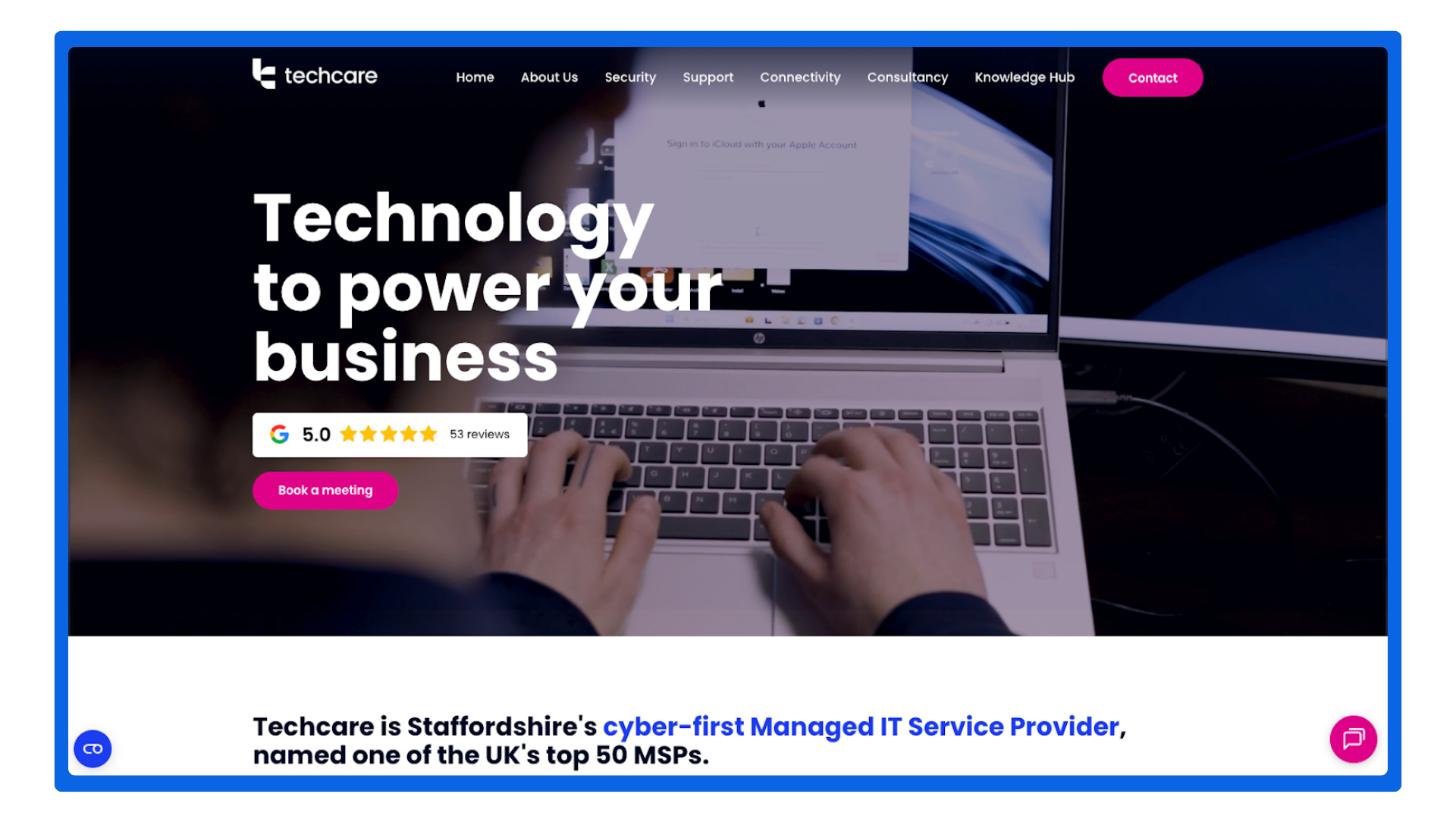Techcare is a UK-based managed service provider (MSP) helping businesses stay connected, secure, and productive — from password resets to full-scale AI integrations. But with a small marketing budget and one person behind the wheel, Emily Keeling, Techcare’s Marketing Manager, needed something powerful enough to reveal critical conversion insights, without overwhelming her time or tech stack.
The challenge: No time for guesswork, no room for risk
In May 2024, Techcare launched a new website as part of a full rebrand. With traffic growing and SEO efforts underway, Emily was under pressure to:
- Validate whether the new site was actually working — were users finding what they needed?
- Give sales more visibility into high-value leads, without adding manual work
- Back up website changes with real user behavior, not just opinions
Even with HubSpot and Google Analytics in place, she couldn’t answer the big “why” questions about user behavior. GA showed traffic. HubSpot showed leads. But what happened in between? She needed visibility into user intent — clicks, scrolls, hesitation, rage — and the ability to act on it quickly.

I’m the only person in the marketing department. So I needed a tool that could do a lot of the work for me.
The solution: From behavior to business impact
Emily now uses Mouseflow for everything from CRO decisions to sales enablement. Here’s how:
1. Smarter sales handoffs with Session Replays
Sales works best when they know what a lead actually wants, not just that they submitted a form. Emily pairs Mouseflow with HubSpot to connect the dots. Every form submission triggers a quick lookup:
- She checks what page the form was submitted on
- Then matches the timestamp and session in Mouseflow
- From there, she watches the full journey, what blog they read, which services they explored, what they hovered or clicked
- That replay is then shared directly in the CRM record, so sales can prep with full context rates throughout 2024.
This approach doesn’t just help sales close faster, it aligns marketing and sales around actual behavior, not assumptions.

It makes us look like mind readers, we can ask better questions and show we understand what the lead really needs.
2. Fixing navigation with hard data
Navigation design is always a battle between visibility and clarity. Teams want to showcase everything — services, testimonials, case studies — but only have room for a few prime spots.
Techcare’s founder suggested adding an “About Us” link to the top nav, believing it was important for visitors to quickly understand who they are and what they do, especially since Techcare provides a people-first B2B service.
But with limited space, Emily had to decide what to remove. Instead of guessing, she turned to Mouseflow heatmaps and click data.
- “Case Studies” was rarely clicked, averaging 48 clicks per month.
- “About Us,” once added, became the most clicked nav item within weeks. This now averages to 143 clicks per month since they have swapped them out at the start of June 2025.
- The “About Us” page became the 4th most visited page, compared to 8th in the prior ranking.
- Emily also found a pattern: many visitors who converted had previously viewed the “About Us” page.
This changed how Techcare understood visitor behavior. Prospects weren’t necessarily ready to evaluate detailed service pages upfront, they wanted credibility and clarity first.

Seeing what people actually do helped us reposition content to match their journey, not just what we assumed they’d want.
3. UX improvements that actually work
With limited development support, Emily had to make sure that every design update delivered results. One early discovery: users weren’t scrolling.
- The homepage hero image was too tall, hiding the section below.
- Mouseflow’s scroll heatmaps showed users were bouncing early.
- Emily resized the hero, added subtle prompts to scroll, and clarified the subheading, inviting users to explore further.

Techcare’s Homepage before changing hero and swapping out Case Studies

Techcare’s Homepage after changing to a hero video, and adding About Us to the top bar
She’s used similar insights across the site to:
- Reposition and wrote blog content to match reading behaviors (users tracking text with their mouse cursor)
- Flag and fix pages with high drop-off rates or friction points
- Shorten forms and improve labels using form analytics

It’s easy to think a page is fine because it looks good. But Mouseflow shows how real people use it, and that’s not always how we expect.
4. Surfacing overlooked audiences and hidden issues
Quantitative data hinted that Techcare’s traffic was growing, but it didn’t show who was visiting or how they behaved. Mouseflow uncovered surprising patterns:
- A higher-than-expected portion of users came from Bing, not Google, especially older B2B buyers with more traditional search habits. This insight led to SEO updates and new traffic from overlooked channels.
- Bot traffic targeting backend pages appeared clearly in session replays, helping Emily rule out false positives and protect lead quality.
- Mobile users were more common than expected, which prompted more rigorous mobile UX testing.
“It’s not just about fixing what’s broken. It’s about discovering things we wouldn’t have even thought to look for,” says Emily Keeling, Marketing Manager at TechCare.
By seeing actual behavior, not just numbers, she was able to prioritize changes based on real-world usage, not assumptions.
Results & Impact
For a one-person team, Emily’s use of Mouseflow multiplied her capacity to make confident decisions backed by behavior, not assumptions.
- 3x increase in clicks on “About Us” after navigation redesign
- Improved lead context for sales, saving time and improving quality of conversations
- Faster iteration cycles on web updates using scroll, form, and friction insights
- SEO strategy pivot to account for a Bing-heavy user base

If someone suggests a change, I check Mouseflow. If the data backs it up, we do it. If not, I have proof to explain why we shouldn’t.
Company: Techcare
Industry: Managed IT Services
Tools used: Mouseflow, Google Analytics 4
Features used in Mouseflow: Friction Detection, Scroll Map, Click Map, Session Replays
